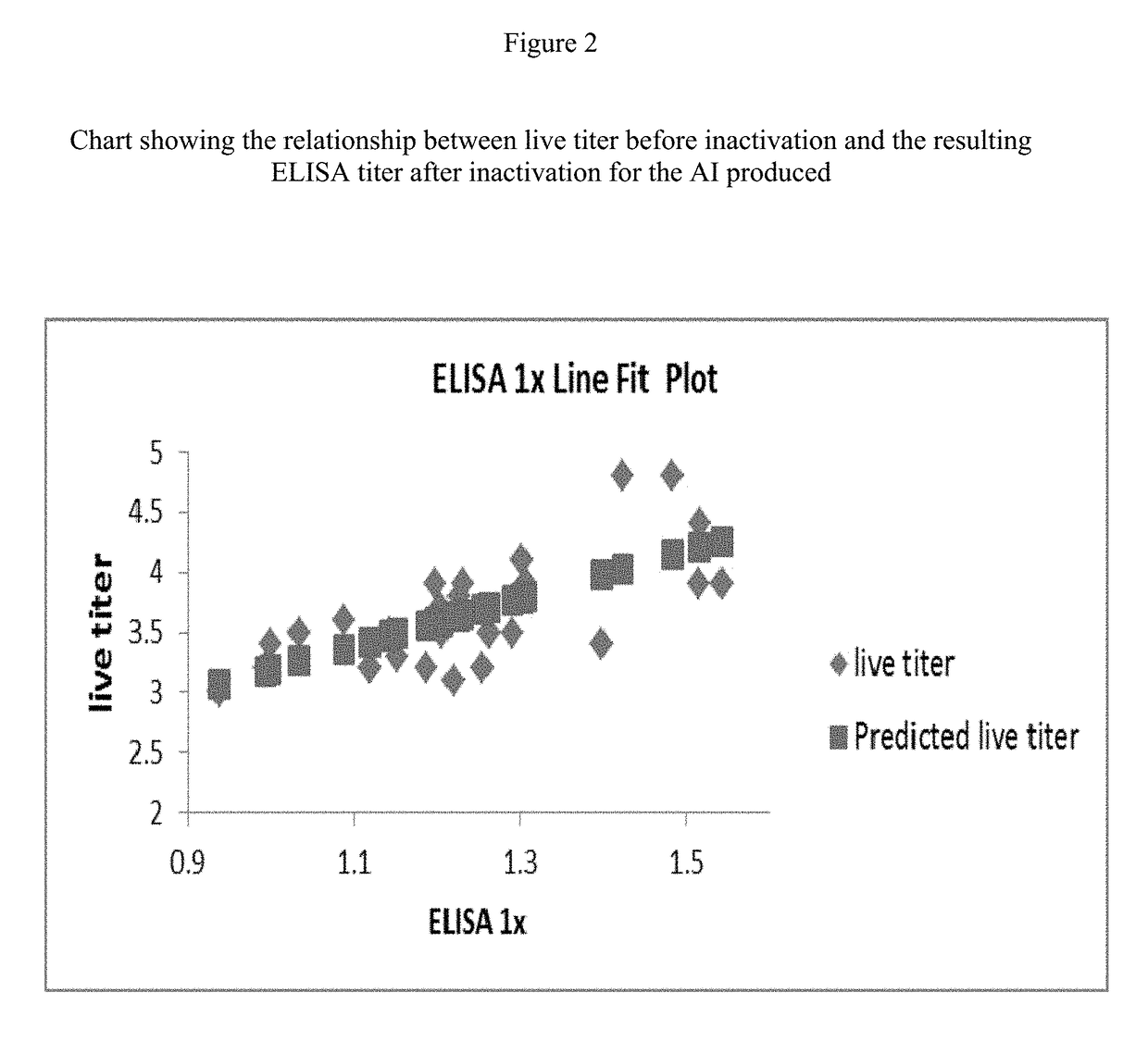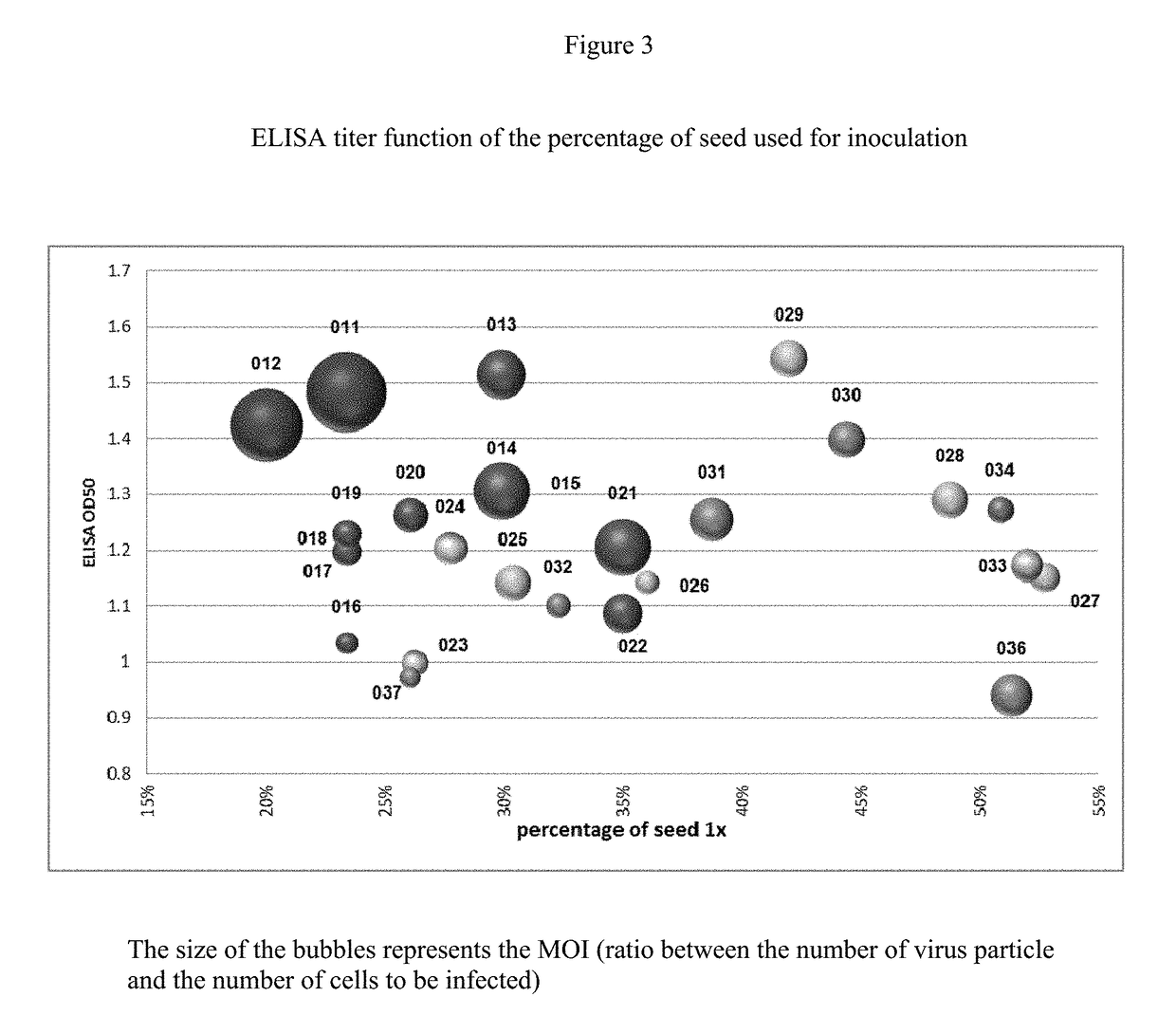Method for porcine circovirus production and PCV2 vaccines
a technology of porcine circovirus and production method, which is applied in the field of porcine circovirus production and pcv2 vaccines to achieve the effects of improving the yield of circovirus, speeding up the cultivation of circovirus, and optimizing and high yield
- Summary
- Abstract
- Description
- Claims
- Application Information
AI Technical Summary
Benefits of technology
Problems solved by technology
Method used
Image
Examples
example 1
Summary of the Current PCV2 Production
[0083]To produce PCV2 active ingredient (AI) for the preparation of inactivated PCV2 vaccine, PK15 seed culture (X passage) was used to amplify the PCV2 virus according to the procedure described below.
X+1 to X+3 Passages in Roller Bottles
[0084]On day 0, PK15 cells (Porcine Kidney) were thawed and suspended in 5% FBS (fetal bovine serum) and 300 ml DMEM (Dulbecco's minimum essential medium). The PK15 cells and the media were dispensed in roller bottles (RBs) at a density of 50 million cells / RB. PCV2 virus (the active ingredient of the licensed CIRCOVAC® vaccine, see U.S. Pat. No. 6,660,27 and U.S. Pat. No. 7,122,192) was thawed and used to infect the PK15 cells (estimated MOI=0.1). The RBs were placed at 37° C. and 0.4 rpm.
[0085]On day 1, the media was removed from the rollers. Enough 20 mM Glucosamine solution was added to each RB to cover the cell layer and then incubated for 30 min at 25° C. The glucosamine treatment is used to allow the pene...
example 2
Improved Method of PCV2 Production
[0098]To produce PCV2 active ingredient (AI) for the preparation of inactivated PCV2 vaccine or the production of PCV2 seed culture, the PK15 cells infected with PCV2 virus (X passage) were expanded to amplify the PCV2 virus (persistently infected cell line) according to the procedure described below. The persistently infected cell line process is illustrated in FIG. 5.
Initial Cell Passage and Infection
[0099]The PK15 cells from the frozen bag were thawed into a 37° C. water bath, re-suspended into growth media (DMEM with 5% FCS) and planted into RB at a density of 50 million cells per RB.
[0100]One day later, the cells were infected with 130 ml of PCV2 seed (the active ingredient of the licensed CIRCOVAC® vaccine, see U.S. Pat. No. 6,660,27 and U.S. Pat. No. 7,122,192) per RB (estimated MOI=0.1). The seed was left in contact with the treated cell layer for 30 minutes at 37° C. on a roller rack. Once the absorption finished, 170 ml of growth media was...
example 3
Live Titer and ELISA Titer Determination
Live Titer—Titration and Identity by Indirect Immonufluorescence of PCV2 Virus in PK15 Cells
[0145]Two- to four-day old PK15 cells were used to prepare a cell suspension of 120,000 cells / ml using DMEM media with 5% FBS, 20 mM glucosamine as the diluent. PCV2 samples were serially diluted with DMEM+5% FBS. 100 ul of diluted PCV2 samples and 100 ul of PK15 cell suspension were added to the wells of a 96-well plate. The plate was incubated at 37±1° C. CO2 for 4 days and rinsed with 100 μl / well PBS. Acetone fixation of the plate was done by adding 100 μl / well of 90% acetone and placing the plate in a −15° C. to −25° C. freezer for 30 minutes. The acetone was then decanted and the plate was air dried completely.
[0146]The monoclonal antibody to PCV2 was diluted 1:200 in PBS and 100 μl / well of the diluted monoclonal antibody was added to the dried plate. The plate was incubated at 37±1° C. and 4±1 CO2 for 25-35 minutes. The plate was washed twice with...
PUM
| Property | Measurement | Unit |
|---|---|---|
| diameters | aaaaa | aaaaa |
| volumes | aaaaa | aaaaa |
| contact time | aaaaa | aaaaa |
Abstract
Description
Claims
Application Information
 Login to View More
Login to View More - R&D
- Intellectual Property
- Life Sciences
- Materials
- Tech Scout
- Unparalleled Data Quality
- Higher Quality Content
- 60% Fewer Hallucinations
Browse by: Latest US Patents, China's latest patents, Technical Efficacy Thesaurus, Application Domain, Technology Topic, Popular Technical Reports.
© 2025 PatSnap. All rights reserved.Legal|Privacy policy|Modern Slavery Act Transparency Statement|Sitemap|About US| Contact US: help@patsnap.com



